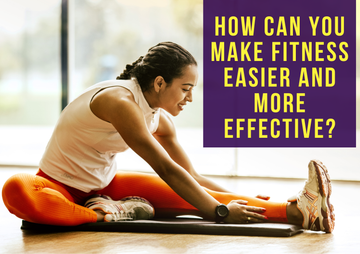How Can You Make Fitness Easier and More Effective?
If the idea of working out feels like yet another item on your never-ending to-do list, you’re not alone. Life is busy. Between work, family, errands, and everything in between, finding time to move and train can feel overwhelming.
But here’s the good news! Fitness doesn’t have to be complicated to work. In fact, some of the most effective workouts are the simplest ones. With the right mindset and a streamlined plan, you can get stronger, healthier, and more energetic without turning your life upside down.
Always Focus on the Basics
Instead of chasing every new workout trend or getting caught up in overly complex routines, concentrating on fundamentals gives you the best return on your time. Choose movements that engage multiple muscle groups: Think squats, push-ups, lunges, pull-ups or rows.
These compound exercises build strength and functionality, making your body work better in everyday life. Research supports this: simplified programs that emphasize key movements tend to be more effective and sustainable. The Top 10 Benefits of Regular Exercise.
- Choose 3-5 foundational exercises and rotate them weekly.
- Prioritize proper form and steady progression over fancy variations.
- Use minimal equipment (bodyweight, bands, or dumbbells) so you can train anywhere.
Short Workouts That Actually Work
You don’t need to dedicate hours each day to see progress. In fact, shorter sessions, especially when consistent, often lead to better adherence and results.
According to workouts that simplify your routine, a few well-designed bursts are more sustainable than long, drawn-out sessions. Circuits, Supersets and Intervals for Beginners.
- Plan 20-30 minute workouts if your schedule only allows it.
- Use circuits, supersets, or full-body sessions to maximize impact.
- Aim for regularity: even 3 sessions per week can move the dial.
Make Movement a Habit, Not a Chore
When working out feels like a punishment or a task you should do, motivation wanes fast. The secret is to embed movement into your lifestyle in ways that feel natural.
Whether that’s walking meetings, stair runs, or playing active games with your family, the more seamless it becomes, the easier it is to stick with! 40 FUN ways to Exercise (Without realizing it!)
- Identify realistic time slots (morning coffee, lunch break, after kids’ bedtime).
- Replace passive habits (scrolling, TV) with light movement.
- Celebrate consistency — training your body is training your routine.
Use Mindset Over Metrics
Rather than obsessing over every metric (how many reps, sets, calories burned), shift your focus to how you feel: more energy, better mood, stronger body. Simplifying your approach helps remove the clutter and decision-fatigue that often derails fitness. How to motivate yourself to exercise: 17 Tips that work.
- Track feelings: “I felt more energetic today” instead of “I burned 500 calories.”
- Avoid “perfect workout” anxiety. Movement is the victory.
- Adjust your goals based on lifestyle, not peer comparison.
Recover Smart and Build Durability
Simplified workouts don’t mean skipping recovery. In fact, rest, sleep, mobility, and flexibility are foundational to sustaining progress. If you train hard but neglect these areas, your body will let you know through fatigue, soreness, or worse.
- Prioritize sleep, good nutrition, and stretching or mobility work.
- Include at least one lighter or active-recovery day each week.
- Recognize that growth happens between workouts, not just during them.
Frequently Asked Questions
Here are common questions people ask when they’re looking to simplify their workouts and clear, realistic answers you’ll actually use.
Is a short workout really enough?
Yes. While longer sessions have their place, many people make more progress with consistent, shorter workouts than with sporadic, long ones. A focused 20-30 minute workout done regularly beats the “gyms once a month” approach.
Do I need high-tech equipment or a big gym?
Not at all. Many effective workouts use just your bodyweight, resistance bands, or basic dumbbells. The key is consistency and movement, not fancy machines or memberships.
How often should I train to see results?
Ideally 3-4 times a week, but it’s more important that you stick with it than train “perfectly”. Even 2 sessions consistently per week are better than one grand session that disappears altogether.
What kind of exercises should I choose?
Pick compound movements, those that use multiple joints and engage several muscle groups (e.g., squats, push-ups, lunges, rows). These tend to deliver the most benefit per minute spent.
What about cardio vs strength training?
Both matter. But if you’re pressed for time, prioritizing strength and full-body movements can provide more benefit. When your strength improves, your metabolism, coordination, and daily movement ease all improve.
My schedule is unpredictable. Can this still work?
Yes. A simplified plan is designed for life, not the other way around. Think flexible: 10-15 minutes when possible, even if you split it up. The consistency of showing up matters more than perfect scheduling.
Will I still get results if I skip days?
Missing an occasional session is normal. If you aim for consistency over time, your body will adapt. The goal is to build habit and momentum, not to punish yourself for every missed day.
Is it safe for beginners or older adults?
Absolutely. A simplified plan is especially well-suited to beginners of any age because it reduces complexity and overload. Focus on foundational movements and gradual progression. Always clear with your doctor if you have health concerns.
How do I avoid boredom with a simple plan?
Keep it flexible. While the core exercises remain simple, you can change tempo, switch environment, use kids or family as partners, or move between indoors/outdoors. Simplicity doesn’t mean stagnation, it means focus.
How long until I see changes?
You’ll likely feel better (more energy, improved mood) within a few weeks. Visible strength changes may take 6-12 weeks of consistent effort. What matters most is the journey and the habit formation.
Conclusion
Fitness doesn’t need to be complicated, time-consuming, or full of gimmicks to work. In fact, one of the most powerful strategies is to simplify. When you strip away the fluff and focus on core movements, consistency, and joy in movement, you’ll find yourself making real progress, whether you’re in your 20s or your 50s, a parent juggling life, or simply someone who wants to move better and feel stronger.
Think of your workout not as a separate chore, but as a life skill you develop, one that supports your energy, your mood, and your daily performance. The less you stress about doing it “perfectly,” the more likely you are to actually do it. So, pick your foundational exercises, plan short sessions, make it fun, recover well, and keep showing up.
The simple workout you stick with may just deliver results you once thought required hours in the gym. Welcome to the smarter side of fitness, moving with purpose, not pressure. Let’s simplify, show up, and thrive!
Check out our previous articles!
10 Benefits Of Working Out With A Friend!
How a 10 Minute Walk Can Improve Your Overall Well Being
6 Light Stretches to Help You Sleep Better
5 Simple Stretches to Relieve Lower Back Pain
3 Fun Ways to Get in Shape with the Agility Ladder
How to Use the Agility Ladder to Gain More Stamina
Flag Football: A Safe and Exciting Alternative to Tackle Football
















